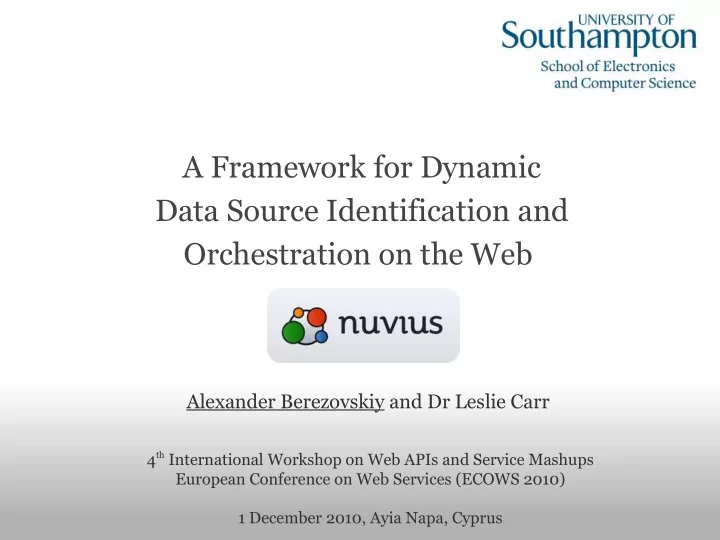

A Framework for Dynamic Data Source Identification and Orchestration on the Web Alexander Berezovskiy and Dr Leslie Carr 4 th International Workshop on Web APIs and Service Mashups European Conference on Web Services (ECOWS 2010) 1 December 2010, Ayia Napa, Cyprus
Problem • Modern Web can be seen as a “universal data machine” • Multitude of web applications, services and data provides • Almost every user has vast amount of data stored online • Data is often duplicated • Users need to register, provide their details, upload photos... • Ideally, we would like a way to universally manipulate the data • APIs are different, functionality depends on data source • We need to know what data source to use • Make adjustments for every data source 2
Current solutions • OpenSocial • Focused on social applications • Requires adjustments in target applications • Integrate every possible resource • Very time consuming • No guarantee the user will be satisfied with the choice • User interaction required to choose the right source 3
Proposed solution • Identify the most appropriate data resource • Task is given, nature of required data is known • Without any user intervention attempt to identify most suitable data resource to perform the given task • Execute the task (process data request) • When data resource is identified, hand the request over to the resource and report on the results (or, return results) • Allow full CRUD (create, read, update, delete) operations on data 4
Proposed solution (cont'd) 5
Data resource identification • One visit to a web page can tell a lot about the user • Country, language, browser, operating system, … • We assume all these parameters affect the user preferences and their choice of applications • Use two-dimensional model: • Information about the user – Country , Language , Age, Occupation, Marital Status, … • Usage information – Browser , Operating System , Web and Local Applications, … • Some information can be obtained from a single HTTP request with no user intervention required 6
Data resource identification (cont'd) • User information is grouped in a single entity called Environment • Data can be structured as a tree: • Identification algorithm: Total score for data source is defined as: a TSA a = TRS a ERS a TRAA a a - Total Relevance Score for TRS a ERS a ,u - Environment Relevance Score for and user a u TRAA a - Total Relevance Application-to-Application score for a 7
Data operations • Each data resource serves data differently • Data operations are performed by “bindings” • These are small chunks of code executed independently • We need at least one for each data resource • They can be written by anyone 8
Data operations (cont'd) • Bindings return data in “raw” format • The data can then be converted to almost any format • Currently available XML, JSON and Plain Text • Can be adjusted to serve RDF • Example binding to return a user's name from Facebook: import urllib import simplejson interface = { 'fields': {'username': {'required': 'yes', 'type': 'text'}}, 'formats': ['html', 'xml', 'txt'] } def run_binding(): url = 'http://graph.facebook.com/' + str(job.input_args['username'][0]) response = urllib.urlopen(url) user = simplejson.loads(response.read()) return user['name'] 9
Demo 10
Demo 11
Demo 12
Demo 13
Demo 14
Demo 15
Demo 16
Demo 17
Demo 18
Demo 19
Discussion • Dynamic discovery of data sources • Data mining can help us read data • How can we do full CRUD on the data? • Universal data addressing • How can we universally address data based on its nature? • Semantic Web application • Can we derive ontologies from the available data? 20
Thank you 21
Recommend
More recommend